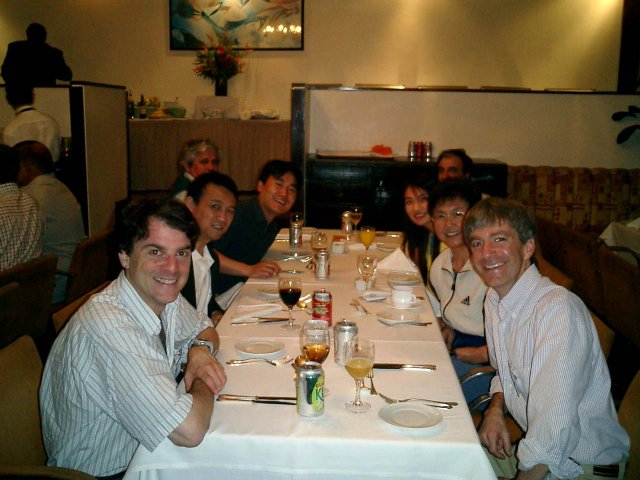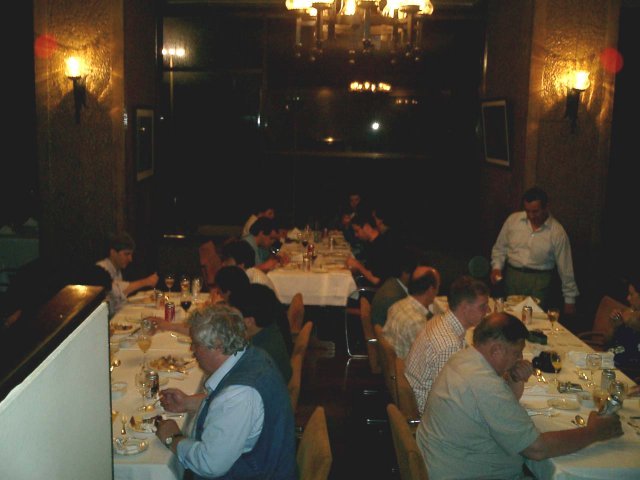POST-CONFERENCE REPORT
The 2005 WSEAS International conferences:
- 4th
WSEAS Int. Conf. on ELECTRONICS, SIGNAL PROCESSING and CONTROL
(ESPOCO 2005) - 4th WSEAS Int. Conf. on APPLIED MATHEMATICS and COMPUTER SCIENCE (AMCOS 2005)
- 4th WSEAS Int. Conf. on SYSTEM SCIENCE and ENGINEERING (ICOSSE 2005)
- 5th WSEAS Int. Conf. on POWER ENGINEERING SYSTEMS (ICOPES 2005)
were held in Rio de Janeiro, Brazil, from April 25 to 27, 2005.
SCIENTIFIC
PART:
Conference Statistics:
Submitted papers: 316
Accepted papers: 169
From these 169 papers, only 28 high-quality papers were selected (as extended
and revised versions) for additional journal publication
The WSEAS Proceedings for this multiconference in Brazil are covered: INSPEC (IEE), AMS (American Mathematical Soceity), Mathematical Reviews, ZENTRABLATT, ISI (ISINET), ELSEVIER, CSA, ELP, NLG, Engineering Index, Directory of Published Proceedings, British Library, Swets Information Services, etc... More Details: www.worldses.org/indexes
The WSEAS published the registered and presented
papers in 3 media: 1 CD-ROM, 2 Hard-Copy, 3 On-line Data Base.
All the members of WSEAS as well as all the authors and co-authors that have
published papers in the WSEAS conferences (since 1996) have now a username
and a password without expiry date. The log files of the server counts 30000
visits per month now in the on-line E-library.
JOURNAL PUBLICATION:
Authors of the best papers will be called to send extended versions
for journal publication.
Student Competition for each conference:
The Technical committees make review now for the papers and several prizes
will be awarded. First Prize, Second Prize, Third Prize for each conference.
Important Keynote Lecturers and Plenary Speakers honored the WSEAS among them the following:
Vision Simulated Imaging
Professor Brian A. Barsky
Computer Science Division and School of Optometry
University of California
Berkeley, California, USA
E-mail:
barsky@cs.berkeley.edu
Vision-simulated imaging (VSI) is the computer generation
of synthetic images to simulate a subject's vision, by incorporating the
characteristics of a particular individual's entire optical system. Using
measured aberration data from a Shack-Hartmann wavefront aberrometry device,
VSI modifies input images to simulate the appearance of the scene for the
individual patient. Each input image can be a photograph, synthetic image
created by computer, frame from a video, or standard Snellen acuity eye
chart -- as long as there is accompanying depth information. An eye chart
is very revealing, since it shows what the patient would see during an eye
examination, and provides an accurate picture of his or her vision. Using
wavefront aberration measurements, we determine a discrete blur function by
sampling at a set of focusing distances, specified as a set of depth planes
that discretize the three-dimensional space.
For each depth plane, we construct an object-space blur filter. VSI
methodology comprises several steps: (1) creation of a set of depth images,
(2) computation of blur filters, (3) stratification of the image, (4)
blurring of each depth image, and (5) composition of the blurred depth
images to form a single vision-simulated image.
VSI provides images and videos of simulated vision to enable a patient's eye
doctor to see the specific visual anomalies of the patient. In addition to
blur, VSI could reveal to the doctor the multiple images or distortions
present in the patient's vision that would not otherwise be apparent from
standard visual acuity measurements. VSI could educate medical students as
well as patients about the particular visual effects of certain vision
disorders (such as keratoconus and monocular diplopia) by enabling them to
view images and videos that are generated using the optics of various eye
conditions. By measuring PRK/LASIK patients pre- and post-op, VSI could
provide doctors with extensive, objective, information about a patient's
vision before and after surgery. Potential candiates contemplating surgery
could see simulations of their predicted vision and of various possible
visual anomalies that could arise from the surgery, such as glare at night.
The current protocol, where patients sign a consent form that can be
difficult for a layperson to understand fully, could be supplemented by the
viewing of a computer-generated video of simulated vision showing the
possible visual problems that could be engendered by the surgery.
Neuroprocessing in Silicon
Professor James F. Frenzel
Electrical & Computer Engineering
POB 441023
University of Idaho
Moscow, ID 83844-1023 USA
http://www.uidaho.edu/~jfrenzel
Despite phenomenal advancements in semiconductor technology over the last five decades, today’s computers still struggle with certain tasks that are easily performed by a young child. One of the first electronic implementations of a pulsed neuron was introduced in 1937 and since then research efforts have covered a wide spectrum, ranging from single-transistor models to powerful parallel processors comprised of digital signal processors. This talk will highlight some of the recent developments in the field of hardware-based neurocomputing and then present work from the University of Idaho. For the last three years, an interdisciplinary team from engineering and computer science has been working toward the development of CMOS circuits capable of mimicking the biological and signal mechanisms observed in the human nervous system. This work, funded by the National Science Foundation, is part of a larger effort within the Neuroscience program at the University of Idaho (http://www.grad.uidaho.edu/neuro).
SOCIAL PART:
The WSEAS Conference participants had several opportunities to meet each
other during the coffee-breaks and banquet.
The coffee-breaks were actually light lunches the guests except the usual
coffee, tea, milk enjoy also a variety of fruits, sandwiches, cheese bread,
pastries, hot chocolate and fruit-tarts.
The official Banquet of the conference took place in the
hotel with an impressive great variety of food,
and beverages.
Some
Photos from the Banquet follow:


The overall impression of the meeting was
excellent.
See also:
http://www.worldses.org/feedback2005.txt